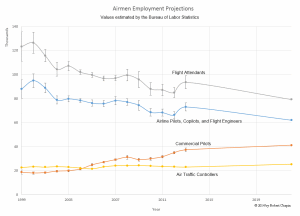
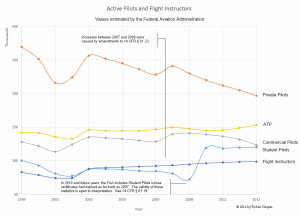
The release of December 2013 airmen statistics indicated another increase in the number of airline-qualified pilots in the United States. Labor statistics also showed an increase in pilot employment last year. As a country, we do not seem to be running out of pilots by any numerical measure.
A deeper analysis is always more interesting, of course. Despite the new hiring for airline pilots, the long term employment projection changed from positive to negative. The reasoning offered with the projection is very similar to my own comments posted earlier this year: Airlines will increase the capacity and efficiency of their fleets to improve profitability. Taken a step further, this could result in fewer flights in the future. This seems to be a pessimistic view, and I do not agree with the idea that airlines would try to effect a long-term reduction of flights. Overall flight reduction is also contrary to the FAA projection of more aircraft operating each year through 2034.
Trends in pilot certification remain mostly unchanged, with the exception of accelerated divergence between ATP and commercial-level pilots, likely due to the regulatory changes requiring existing pilots to upgrade. That regulatory effect will stabilize after 2014, but will remain divergent due to the permanence of upgrades. The overall lack of trend changes between 2011 and 2013 is significant because the FAA continues to project trend reversals for private pilot and commercial pilot numbers. This casts further doubt on the new projections for private and commercial pilot certification to increase. Our general aviation sector has been losing around 8,000 private pilots and 2,000 commercial pilots per year since 2003. Given that momentum, the GA numbers could easily fall another 10% to 20% or more before reversing.

While projections for private and commercial pilots seem clearly too optimistic, the projection for active ATPs seems pessimistic. I hate to say that there are going to be a lot more ATP certificates issued in the future, but that looks like the direction. In addition to required upgrades from commercial to ATP, the full effect of R-ATP regulation has yet to be seen. This means it is not only required, but also easier than ever before to upgrade from commercial to ATP. The projected increase of 9%, spread over 20 years was a sensible projection back in 2012, but not now.
Age has been another underlying trend in the so-called pilot shortage. Although I did not address this point directly in my previous post, I decided to look at several more piles of numbers dealing with age, which I have arranged into more graphs below to help illustrate this trend. For airline pilots, the graph is as expected. Pilots aged 50 to 69 are adding on to the active pilot statistics by the tens of thousands. Meanwhile, airline pilots aged 30 to 44 are getting older over time and are not being replaced by the tiny fraction of younger pilots who fall into the 25 to 29 range. That may sound like a dire trend, but it all depends on whether the demand for new pilots is being met, and so far it is.
The commercial pilot age trend is more interesting. While most age groups have been in rapid decline since 2003, the 25 to 34 range saw a huge increase between 2008 and 2011. Another fast growing group of commercial pilots is the 65 to 69 range. I wish I could explain why those particular groups stand out, but I would just be guessing at this point.
The private pilot age trend graph shows some useful sub-trends. Among all private pilots, those aged 35 to 54 are the ones leaving the active total at a brisk pace. Other age groups are relatively stable or even increasing.
In response to reader feedback, I also included employment statistics for flight attendants and air traffic controllers in one of the graphs above. Those occupations are slightly outside my area of expertise, so the analysis is up to the reader to do. Please feel welcome to continue the discussion below.
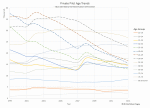
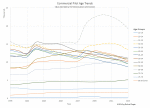
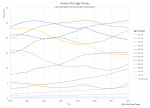
3 responses to “Pilot Shortage Update”
very nice article bob.
first let me say there are roughly 260,000 faa atp and commercial license holders and perhaps 200,000 of them hold or could obtain a first class medical and more than 1500 hours (the comm holders) there are 66,000 airline jobs in the usa (as per alpa info) therefore 3 pilots for every job.
second , there were 8400 new atp issued last year. the airlines state they will hire 18000 new pilots over next 8 years. thats 2250 a year BUT 8400 atps were issued and lets say some were issued to non us citizens or helo or those who fly for fun and 6750 want to fly in usa, that is around 3 pilots for every job. yes places like great lakes who pay 1400 dollars a month cant find pilots due to a pilots inability to re-pay their student loans with such a small salary but ups received thousands of applicants for their 40 new jobs they job advertised for. there is and will not be a “pilot shortage”
It’s now 2018, 3 1/2 years after the post was written and perhaps more applicable to me the response. I am preparing to leave my current job and am struggling with the decision. If in fact there is no pilot shortage than perhaps the risk of attempting to go to the airlines is too great and the hype that the airlines are short is still just that, hype. I would make the leap as a mid 40’s ex Mil Rotor pilot and only need my AMEL add on at this point, (of course ATP-CTP still required). I would love to hear an update on the perspective of shortage or no shortage. I have read articles that state the shortage is only in the Regionals. Does this mean the challenge for a Mil Rotor Pilot getting to the Majors remains probable but not likely? I welcome any feedback and any additional thoughts or considerations.
Hi Brandon, thank you for writing. Yes, there have been some significant changes in 3.5 years. I will be sure to let you know if I write an update on the topic. Enjoy.